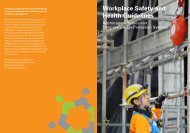Confined Spaces - Workplace Safety and Health Council
Confined Spaces - Workplace Safety and Health Council
Confined Spaces - Workplace Safety and Health Council
- No tags were found...
Create successful ePaper yourself
Turn your PDF publications into a flip-book with our unique Google optimized e-Paper software.
The risk assessment shall determine the combination of confined space rescue strategiesappropriate for the particular situation.It is important for suitable <strong>and</strong> sufficient emergency arrangements to take account of:• Rescue considerations;• Rescue logistics;• Training of rescue personnel;• Provision of rescue equipment; <strong>and</strong>• Provision of safety data sheet.8.3 Rescue ConsiderationsIt is advisable to always consider a confined space as immediately dangerous to life <strong>and</strong> health(IDLH) unless proven otherwise. Plan <strong>and</strong> prepare emergency response <strong>and</strong> rescue procedures forall confined space entry work. These procedures must be in place before any work commences.It is important to note that a very short period, approximately four minutes, without adequatebreathing can cause a worker to suffer permanent brain damage due to lack of oxygen.8.3.1 Characteristics When Deciding the Appropriate Rescue PlanIt is important to consider the following characteristics when deciding the appropriate rescueplan for a confined space entry work:Internal Configurationi. Open — there are no obstacles, barriers, or obstructions within the space. One example is awater tank.ii. Obstruction — the space contains some type of obstruction that a rescuer would need tomanoeuvre. For example, a baffle or mixing blade. Large equipment, such as a ladder orscaffold, brought into the space for work purposes would be considered an obstruction if thepositioning or size of the equipment would make rescue more difficult.Elevationi. Elevated — a permit space where the entrance or opening is above ground by 4 feet or more.This type of space usually requires knowledge of high angle rescue procedures because ofthe difficulty in packaging <strong>and</strong> transporting a victim to the ground from the space.ii. Non-elevated — a permit space with the entrance located less than 4 feet above ground. Thistype of space will allow the rescue team to transport an injured worker normally.Portal Sizei. Restricted — A portal of 24 inches or less in the smallest dimension. Portals of this size are toosmall to allow a rescuer to simply enter the space while using SCBA. The portal size is also toosmall to allow normal spinal immobilisation of an injured worker.ii. Unrestricted — A portal of greater than 24 inches in the smallest dimension. These portalsallow relatively free movement into <strong>and</strong> out of the permit space.Space Accessi. Horizontal — The portal is located on the side of the permit space. Use of retrieval lines couldbe difficult.ii.Vertical — The portal is located on the top or bottom of the permit space. Rescuers must climbdown or up the permit space respectively to enter it. Vertical portals may require knowledgeof rope techniques, or special patient packaging to safely retrieve a downed entrant.For confined space entry, it is important for the authorised manager to designate a st<strong>and</strong>byworker; one or more workers who are trained in industrial first aid, <strong>and</strong> also trained in confinedspace emergency <strong>and</strong> rescue procedures. It is necessary that the designated st<strong>and</strong>by worker bepresent <strong>and</strong> remain at the entrance to the confined space at all times while his co-worker is inthe confined space.The authorised manager shall ensure that openings for entry <strong>and</strong> exit to a confined space are ofadequate size to permit rescue of all persons who may enter a confined space. The openings arenot obstructed by fittings or equipment which could impede rescue. It is important that rescuersbe trained in <strong>and</strong> follow established emergency procedures <strong>and</strong> use appropriate equipment <strong>and</strong>techniques (such as lifelines, respiratory protection, <strong>and</strong> st<strong>and</strong>by person).8.3.2 Conducting of DrillsIt is important that all parties involved in a potential rescue operation underst<strong>and</strong> <strong>and</strong> agreeon the emergency <strong>and</strong> evacuation procedures. It is necessary to include all steps for saferescue in the confined space entry procedures. It is also critical for a rescue to be well planned<strong>and</strong> evidence to be made available that indicates drills have been frequently conducted onemergency procedures. A rescue drill in a confined space shall be held at least once in every12 months. The record of such a drill should be kept <strong>and</strong> should include the time, date of drill,personnel involved, a short description of the drill <strong>and</strong> the evaluation of the drill.It is also important to note that workers who are not trained in proper rescue procedures shouldnot undertake or be permitted to undertake rescue operations.8.4 Rescue LogisticsIt is important to give careful consideration on the means of raising the alarm <strong>and</strong> carrying outa rescue. This emergency plan needs to be suitable <strong>and</strong> sufficient for all anticipated accidents.It is necessary to put in place measures that enable those in the confined space to communicateto others outside the space who can initiate rescue procedures or summon help in an emergency.The emergency can be communicated in a number of ways, for example, by the tug of a rope, byradio or by means of a “lone worker” alarm. Whatever the system, it should be reliable <strong>and</strong> testedfrequently. Depending on the risk assessment, it may be necessary to have one or more st<strong>and</strong>bypersons located outside the confined space whose function is to keep those inside in constantdirect contact including visual where feasible, in case of an emergency.It is also important to give careful consideration on the selection of an appropriate confinedspace rescue strategy. Retrieval using non-entry methods is preferable to rescue by entry <strong>and</strong>should be used where practicable.Where entry is necessary, it is important to ensure the rescuers are protected from the risk ofinjury <strong>and</strong> to address any emergency situation.52 53
















